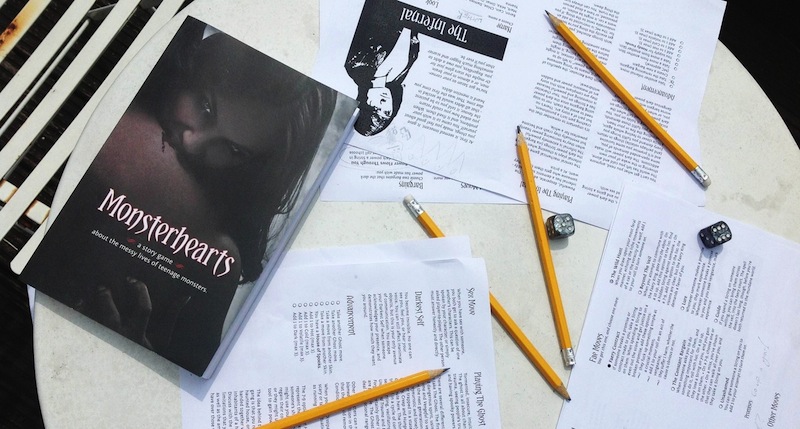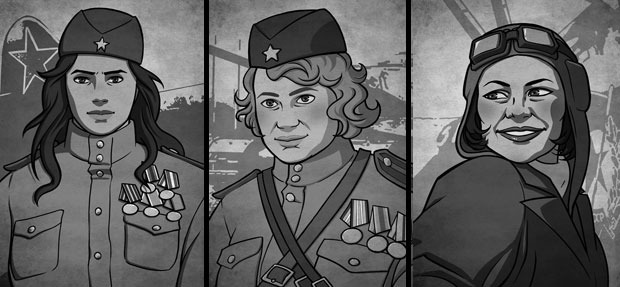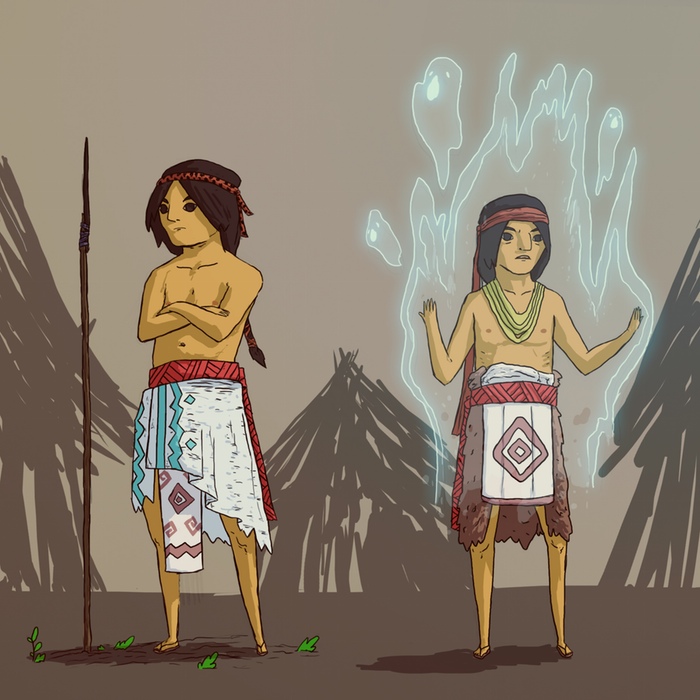Role-playing games offer participants limitless opportunities to explore new places, characters, and ideas. Do you want to be a vampire pirate? Cool! A cyberpunk android? All right! Do you want your game to take place in a medieval fantasy kingdom, a post-apocalyptic dystopian wasteland, or even other galaxies? No problem! With imagination the only barrier for what can be created, there should be a vast field of narratives told through games. Yet, role-playing games are often more narrowly defined.
Role-playing games have an established history of leaving setting and characters a blank slate, while often loosely drawing inspiration from Western themes. For example, when I was a kid and I played Dungeons and Dragons with my friends, we came in with unexamined expectations—the city we saved was always filled with white people, the mayor of the town was always a man, the kingdom was always vaguely built around an imagined medieval Europe. As an adult, I still see these elements and themes repeated in games today.
This is a common pitfall that minority advocates in gaming have come to call “defaultism.”
Defaultism is the idea that we fall back on the status quo when something is not defined. We go with what is most familiar and “normal.” White Americans are a little over two-thirds of the population, but the vast majority of our media is dominated by this demographic, not just in games, but movies, TVs shows, and books. Because of the primacy of white characters in media, if a character is not explicitly stated to be of a different race they are often assumed to be white. Similar problems arise with gender expectations and sexual orientation. Women are commonly typecast as secondary characters, like the love interest, or the victim, while queer characters are rarely seen, or used only as comic relief. Most gamers unconsciously gravitate to the straight white male as our hero, our role model, and the baseline for play.
When defaultism is the norm, vast groups of people and entire cultures are left unexplored and unused in games. These are lost opportunities to engage our imagination, to roam in rich, fertile and vibrant territory. Simultaneously, lack of representation makes the role-playing hobby harder to access for minorities. Without seeing themselves in these stories, why would they participate? The answer is that many times they don’t. I know that in my case, I was pulled in at a very young age. I may have turned away from role-playing games if I had come to them as an adult.

Specifically employing minority settings in RPGs is an easy and direct way to punch through defaultism. Changing the setting alters the cultural foundations of the world on which everything else is built, causing a fundamental shift and opening up access to viewpoints and stories that rarely get told. This can deeply enrich the storytelling while also making the game accessible to a wider audience, signaling to underrepresented groups that the narratives that speak to them are part of the fabric of the game. It’s a win-win.
For example, I am writing for a tabletop RPG called Dead Scare (a pun on “red scare”)—it’s a game about 1950s housewives fighting off zombies after the Soviets dump biological weapons on suburban America. The game takes a step away from the default right away, because it focuses specifically on women and their children surviving and fighting on their own merit and skill in an era where both were disempowered by society and largely voiceless outside the home. Women in the United States were not even able to apply for a credit card without their husband’s approval until 1974!
The creator of Dead Scare, Elsa Henry, contacted a handful of designers to create setting snapshots for her game called “Postcards from Across America.” She was looking for untold stories and I decided to write about Tulsa, and focus specifically on the Greenwood District. Once called Black Wall Street, Greenwood was a thriving community in north Tulsa that created unprecedented prosperity for itself in a time when Blacks all over the country still struggled against Jim Crow laws, overt threats and lynching from racist groups like the KKK, and extreme systemic oppression. The neighborhood boomed with businesses, hospitals, and even a number of privately owned bi-planes. It was an amazing and inspiring community. It wouldn’t last, though.
In 1921 there was a race riot that tore Greenwood down to its very foundations. White people invaded the district, looted, burned, murdered, and even stole the planes and bombed the neighborhood from the air. It’s estimated that hundreds died, and thousands more black people were arrested and held in camps for simply existing in the area while white people were trying to kill them.
Greenwood never recovered. Not ever. When people tried to rebuild they found that insurance schemes made it impossible. When they tried to open their businesses back up they were stymied at every turn. To add insult to injury, the events of the race riot were blacked out from local and state history. Newspaper articles about it went missing from archives. It was not taught about at the local schools. It was purposely forgotten. I attended university and worked in Tulsa and saw first-hand the lasting impact of the riots on its people.
Greenwood in the 1950s was still struggling to recover from the race riot, and still retained some margin of hope. Both the ghosts of prosperity and ruination clamored within living memory. What must it have been like for a woman, a community member in Greenwood, to live her life there? To remember how things used to be, so promising, so golden, and then having to live with the bitter ashes of the present? How would a person informed by this reality deal with the events of a red scare come true? What kind of story would unfold? Certainly, her experiences would be dramatically different than that of her middle-class white counterpart living just a few miles away with her picket fence and chrome toaster.

It’s a compelling narrative, and as it turns out, the Tulsa race riot is something a lot of people still haven’t heard of before, despite it being the single worst incident of racial violence in American history. And here is the other point to working minority settings into the gaming experience: they are a way to unearth the hidden past and bring to light stories that are powerful and moving, but willfully forgotten or minimized by the majority. Engaging with these people and places builds empathy, understanding, and context for lived experiences that need to be brought into the mainstream, recognized, and understood.
Exploring the history of Greenwood through games struck a chord with others. James Mendez Hodes, who is developing a game called AfroFuture with the assistance of Different Play, asked me to work with him on a Greenwood setting for his game. Jaydot Sloan of Vanity Games made a Steal This Character profile for Dead Scare which featured a young black girl named Harriet Smythe.

The excitement over minority settings does not begin and end with a single piece, however. Jason Morningstar’s recently released game Night Witches, which is explicitly about female bomber pilots in the Soviet air force during WWII, made nearly 1000% of its Kickstarter goal. Urban Shadows by Andrew Medeiros and Mark Diaz Truman, an urban fantasy game that asks questions about ethnic identity in an attempt to capture the diversity of cities, made well over 1000% of its Kickstarter goal. Avery Mcdaldno’s Monsterhearts, a game about teenage monsters and the complexities of sexuality and queerness, was short-listed for five major gaming awards.
There is also the game Bluebeard’s Bride, which I am currently developing with designers Marissa Kelley and Sarah Richardson in cooperation with Magpie Games. It’s a tabletop horror game based off of the original fairy tale, and it focuses explicitly on the themes of feminine horror and agency, a first of its kind in pen-and-paper. Through the eyes of the Bride and her exploration of Bluebeard’s mansion, which is also her prison and perhaps her doom, the game examines what it means to be a woman in untenable situations. The game is still in the playtesting phase, and has not been officially released yet, but was one of the most popular games at both the Metatopia and Dreamation conventions.

It’s important to point out that sometimes games make an effort towards diversity, fail, and go back to make corrections. This is not only okay, this is great! Game making is an iterative process, and by failing we often learn much more about what works and what doesn’t. For example, in an effort to ensure that How We Came To Live Here engages the culture and myths of the indigenous peoples that inspired the game, the designer Brennan Taylor has temporarily halted sales of the game as he works with Native American consultants to improve it. The Strange was initially criticized for its approach in depicting Native American people and its use of stereotypes, but Monte Cook Games is now working with Native American writers to fix these issue moving forward.
Despite the propensity for leaning on default Western narratives aligned with the white male experience, minority settings and stories are not only accepted, but hungered for, not just in tabletop, but in video game RPGs, too. Video games have been as prone to defaultism as tabletop, yet we are seeing movement here as well. Never Alone by Upper One Games tells Alaskan indigenous stories through its protagonist, the Iñupiaq girl Nuna and her Arctic fox. Never Alone was developed in cooperation with the Cook Inlet Tribal Council, which works with the local native population. It was nominated for several different awards, including South by Southwest’s Cultural Innovation Award and the British Academy of Film and Television Arts’s Best Debut.

Similarly, Lienzo, a Mexican studio is producing a game called Mulaka, which I’m consulting for on the U.S. side of development. Mulaka is an RPG based around the mythology of the Rarámuri, an indigenous people of Chihuahua. The Rarámuri culture has a rich living mythology, but has had almost no exposure outside a handful of dedicated anthropologists. Mulaka is both a vehicle of culture preservation for the Rarámuri, and a way to share their culture with others. Mulaka has garnered a lot of attention from the press, and even interest from the Smithsonian, despite the early stage of the game’s development.
Currently, the greatest interest shown in exploring non-normative narratives in both analogue and digital settings has been by independent gaming companies. In part, this is probably because the larger companies have financial stakes in long-existing franchises and there is a perceived risk in alienating the core audience if a franchise moves away from the status quo. While some companies like Paizo and Wizards of the Coast are changing, progress is slow.
However, you can make a setting for your favorite game, and publishing games has now become easier than ever. Cheap and accessible printing technologies have made the process of publishing far less complicated, and crowdfunding platforms like Indiegogo, Patreon, and Kickstarter provide the capital to get it done. We may be on the cusp of a renaissance in role-playing games, a movement where voices otherwise unheard in gaming now have access to speak through the medium.
The opportunity to release our imagination in new, unexplored avenues through gaming is vital to making the hobby accessible and open to all. When we create games that incorporate minority themes, it signals to underrepresented groups that their stories are valuable and acknowledged and it tells them that they are welcome and wanted in the geek community. It also shines light on powerful and fascinating narratives that would otherwise be hidden away. Minority settings give visibility to huge parts of the world, past and present, that in our media goes largely ignored. And it helps break negative stereotypes by connecting us with the lived experiences of real people. At its best, we can learn about each other through the games we play, building greater communication and empathy into our own lives, and making our worlds all the richer.
Whitney “Strix” Beltrán is a mythology and games scholar as well as a designer, consultant, and advocate in the gaming community. Find out more about her at her website or on Twitter.









